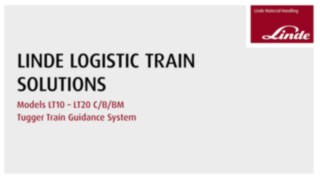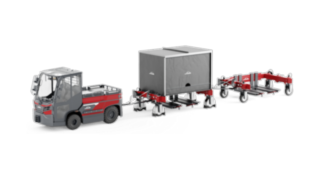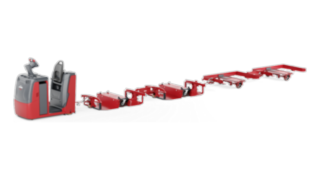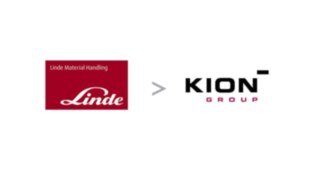Swift through narrow corridors
Linde’s LT10 – LT20 logistic trains are an efficient solution for bundling horizontal transports of large quantities of materials over longer distances, for example from a warehouse to several production lines. The three frame variants, C-Frames, B-Frames and B-Frames with middle support, can hold up to 2000 kilograms, 1000 kilograms and 1600 kilograms respectively, and offer the flexibility to combine different loads on one train. Whether pallets, grid boxes or small load carriers, transport goods of up to 2000 kilograms per frame are manoeuvred quickly, nimbly and with stability, even through narrow aisles and tight curves. The frames can be towed by either a manual or an automated tractor. Linde supports its customers with an optional tugger train guiding system for integration into digitally controlled processes and to ensure efficient use of the trains.
Characteristics
Safety
In order to ensure the goods being transported are secure, it is not possible to start the train when the frames are lowered due to the starting lock and whilst travelling the lifting function is deactivated. Each frame is also equipped with a mechanical locking device that holds the load securely on the frames during travel. As soon as a container is placed on the frame, the lock closes automatically. The patented lifting mechanism of the forks has a tilt function that ensures the same ground clearance for all loaded trolleys, even with heavy loads. The all-wheel-steering allows a precise tracking behaviour and avoids a pull out of the frames, which increases the safety in operational traffic.
- Load locking on all frames secures the transport goods
- Travelling prevention while frames are lowered
- Deactivated lifting function while driving
- Tilt function of the forks for same ground clearance, even with highest payloads
- All-wheel steering enables precise tracking behaviour without pull out of the frames
Ergonomics
The logistic train offers an ergonomic solution for load handling through ground-level loading and unloading. All frame modules of the Linde logistic trains are connected to each other and to the tractor via data cables. The lift function can be controlled simultaneously for all frames as well as individually for each frame. The ergonomic ejection mechanism within the C-Frame pushes the load away from the back as soon as the operator releases the lock by foot. An option is available for the Bridge-Frames that allows the load to be removed from both sides. This allows the operator to push the load carrier through the frame, which reduces their heavy goods workload. The logistic trains also run quietly thanks to the electric lifting function.
- Support for the operator through simultaneous and individual lifting
- Ergonomic ejection mechanism on C-Frame and optional push-through on Bridge-Frame simplify the handling of heavy loads
- Low noise emission
Handling
The frames are equipped with a mechanical all-wheel steering. This allows the logistic trains to be manoeuvred extremely precisely. They are characterised by small turning circles, directional stability and tipping stability. The frame modules are available as C-Frames, Bridge-Frames and Bridge-Frames with adjustable middle support, which are automatically raised for transport and lowered again for unloading. This speeds up loading and unloading. By moving the middle support, different load sizes can be transported in one frame. The patented lifting profile mechanism also allows pallets to be picked up without a rolling load carrier if for example these have been placed in the frame with a pallet truck. The optional tugger train guiding system determines the optimal route, reduces error rates and training times, and responds to order changes in real time.
- All-wheel steering for small turning circles and high directional stability
- Fast lift function when getting on and off
- Adaptation to different transport goods due to movable middle support
- Patented lifting profile mechanism allows pallets to be transported without a rolling load carrier
- Optional tugger train guiding system for integration into digital processes
Service
The current status of the connected frames is visualised on the touch display at the operator’s station. The lifting motors on the frames are maintenance-free and electrically monitored in order to guarantee safe transportation in every situation. The tow bar in combination with the coupling ball hook is almost wear-free. The two-axle design with a central load space also ensures easy access for maintenance. Each frame is equipped with its own hour counter. This facilitates maintenance planning for the overall combination of tractors and frames. Standardised interfaces with pre-defined functions allow the frames to be used in conjunction with manual or automated tow tractors at any time without the need for retrofitting.
- Current status of each frame visualised on touch display
- Maintenance-free and electronically monitored lift motors
- Largely wear-free tillers and couplings
- Easily accessible and low-maintenance design of the frames
- Hour counter for each frame facilitates maintenance planning
- Prepared for automation through standardised interfaces
Videos & Images

Technical Data
| Model | Load capacity/Load | Lift | Lift function | Overall length | Overall width |
|---|---|---|---|---|---|
| LT10-B | 1.0 (t) | 60 / 50 (mm) | Electric | 4050 / 2950 (mm) | 1470 (mm) |
| LT10-BM | 1.0 (t) | 60 / 50 (mm) | Electric | 4350 / 3250 (mm) | 1470 (mm) |
| LT16-BM | 1.6 (t) | 60 / 50 (mm) | Electric | 4350 / 3250 (mm) | 1470 (mm) |
Optional Equipment
-
Frame opening direction
-
Middle support
-
SE wheels
-
Lift heights
-
Rear lights
-
Rotating beacon
-
Weather protection
-
Trolleys
-
Tugger train guidance system
-
Push-through option for B-Frame
-
Additional lifting function on the frame

Frame opening direction
The standard opening side of the C-Frames is the right side. Optionally, the left side in the driving direction can also be chosen for a load exchange.

Middle support
The Bridge-Frame can be equipped with a flexible middle support, which can be moved against the driving direction to the required position. This allows different load sizes to be handled with one frame type.

SE wheels
For outdoor applications, the frames can be equipped with robust super elastic (SE) wheels with a diameter of 250 mm and a width of 85 mm or 130 mm. These wheels are fully suspended, which makes them perfectly suitable against vibrations.

Lift heights
The standard lift height is 50 mm, which is perfectly suitable for most indoor applications. For outdoor applications, the Bridge-Frames can be equipped with an increased lift height of 80 mm and the C-Frames with an increased lift height of 100 mm. Other lifting heights can be requested for special applications.

Rear lights
There is a four-function LED rear light set with magnetic holder and two lights (indicator, rear lights, brake lights, licence plate light) available in clear glass. It provides sealed waterproof housing, e4 marking and assignment according to ISO 1724.
Rotating beacon
A flashing light can be located at the top of the trailer in order to make the logistic train visible, especially in dark areas.

Weather protection
A manually operated tarpaulin roof is available for the C-Frames with a one-sided opening and for the Bridge-Frames with a two-sided opening.

Trolleys
Linde offers trolleys in various designs. They form the interface between the load and the tugger train and can be equipped with modular racking superstructures, for example.
Tugger train guidance system
The tugger train guidance system coordinates the operating orders and provides the operators with the optimal routes. The software dashboard shows all essential information at a glance and can be used to generate analyses for process optimisation.
Push-through option for B-Frame
With the standard lock, the load can only be pulled out in the direction of the operator. With the push-through option, the trolley can be pushed out through the frame in both directions, making heavy loads easier to handle for the operator.
Additional lifting function on the frame
In addition to controlling the lift function via the display on the towing vehicle, the lift can also be controlled via a button on the frame.
Get a Quote



